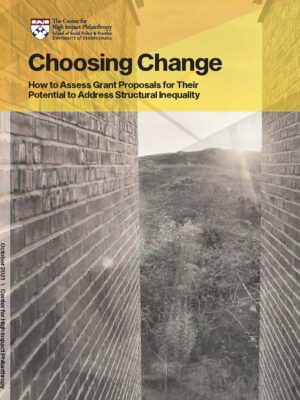FEATURED VIDEO
Choosing Change: Assessing Grant Proposals for Their Potential to Reduce Structural Inequality
Individual donors and institutional grantmakers in all fields have sought to address the structural inequalities that prevent people from surviving, let alone thriving. We identified five dimensions funders can use to assess whether a proposal has potential to reduce structural inequality — or reinforce it. Panelists include Cecilia Conrad, MacArthur Foundation; Kat Rosqueta, Center for High Impact Philanthropy; Angie Murimirwa, CAMFED International; Maanda Ngoitiko, Pastoral Women’s Council; Sonya Passi, FreeFrom; Lauren Sato, Ada Developers Academy; and Jeff Ubois, Lever for Change.
Our Guidance

Choosing Change: How to Assess Grant Proposals for Their Potential to Address Structural Inequality
The COVID-19 global pandemic exacerbated longstanding disparities by race, gender, and socioeconomic status. Individuals, communities, and countries that were already vulnerable were even more at risk. The Choosing Change toolkit can help individual donors and institutional grantmakers at all levels identify proposals and teams whose work addresses the structural inequalities that prevent people from surviving, let alone thriving.
The Choosing Change toolkit can help donors and funders at all levels identify proposals and teams that have potential to create significant positive impact in the world.

A Broad View of How Philanthropy Can Help Any Social Issue
Across the many social impact areas our team has analyzed, we find that philanthropic support typically falls within one of four categories of ways that philanthropy can help. Similar to financial investment asset classes, these categories often reflect different levels of risk, time frames for results, and social impact return profiles. All have potential for high impact. However, some funders may lack the expertise, patience, risk-tolerance, networks, or personal comfort level to invest in all categories. In addition, criteria for selecting ways to help and types of evidence for assessing progress differ among these categories. Throughout this guide, we will provide specific examples of ways to help within each of these categories, matched to each of the five strategies that emerged from our applied research.



